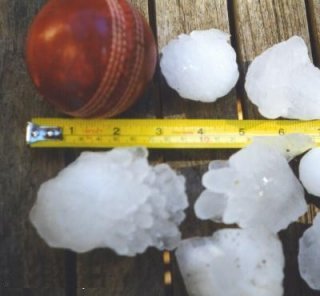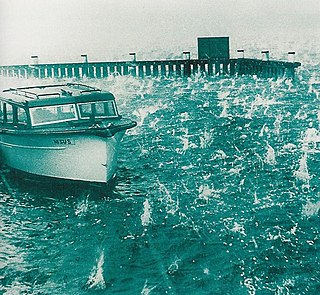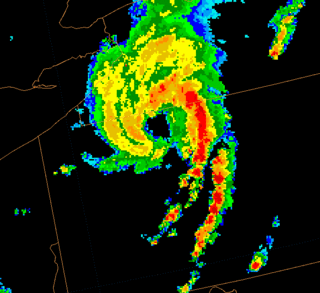
Hail is a form of solid precipitation. It is distinct from ice pellets, though the two are often confused. It consists of balls or irregular lumps of ice, each of which is called a hailstone. Ice pellets fall generally in cold weather while hail growth is greatly inhibited during cold surface temperatures.

A thunderstorm, also known as an electrical storm or a lightning storm, is a storm characterized by the presence of lightning and its acoustic effect on the Earth's atmosphere, known as thunder. Relatively weak thunderstorms are sometimes called thundershowers. Thunderstorms occur in a type of cloud known as a cumulonimbus. They are usually accompanied by strong winds, and often produce heavy rain and sometimes snow, sleet, or hail, but some thunderstorms produce little precipitation or no precipitation at all. Thunderstorms may line up in a series or become a rainband, known as a squall line. Strong or severe thunderstorms include some of the most dangerous weather phenomena, including large hail, strong winds, and tornadoes. Some of the most persistent severe thunderstorms, known as supercells, rotate as do cyclones. While most thunderstorms move with the mean wind flow through the layer of the troposphere that they occupy, vertical wind shear sometimes causes a deviation in their course at a right angle to the wind shear direction.

A storm is any disturbed state of an environment or in an astronomical body's atmosphere especially affecting its surface, and strongly implying severe weather. It may be marked by significant disruptions to normal conditions such as strong wind, tornadoes, hail, thunder and lightning, heavy precipitation, heavy freezing rain, strong winds, or wind transporting some substance through the atmosphere as in a dust storm, blizzard, sandstorm, etc.

A supercell is a thunderstorm characterized by the presence of a mesocyclone: a deep, persistently rotating updraft. For this reason, these storms are sometimes referred to as rotating thunderstorms. Of the four classifications of thunderstorms, supercells are the overall least common and have the potential to be the most severe. Supercells are often isolated from other thunderstorms, and can dominate the local weather up to 32 kilometres (20 mi) away. They tend to last 2-4 hours.

Severe storms in Australia. refers to the storms, including cyclones, which have caused severe damage in Australia.

Severe weather refers to any dangerous meteorological phenomena with the potential to cause damage, serious social disruption, or loss of human life. Types of severe weather phenomena vary, depending on the latitude, altitude, topography, and atmospheric conditions. High winds, hail, excessive precipitation, and wildfires are forms and effects of severe weather, as are thunderstorms, downbursts, tornadoes, waterspouts, tropical cyclones, and extratropical cyclones. Regional and seasonal severe weather phenomena include blizzards (snowstorms), ice storms, and duststorms.

Atmospheric convection is the result of a parcel-environment instability, or temperature difference layer in the atmosphere. Different lapse rates within dry and moist air masses lead to instability. Mixing of air during the day which expands the height of the planetary boundary layer leads to increased winds, cumulus cloud development, and decreased surface dew points. Moist convection leads to thunderstorm development, which is often responsible for severe weather throughout the world. Special threats from thunderstorms include hail, downbursts, and tornadoes.

The British Isles are an archipelago off the northwest coast of Europe, consisting of the islands of Great Britain and Ireland along with smaller surrounding ones. Its position allows dry continental air from Eurasia to meet wetter air from the Atlantic Ocean, which causes the weather to be highly variable, often changing many times during the day. It is defined as a temperate oceanic climate, or Cfb on the Köppen climate classification system. It is significantly warmer than other regions on the same latitude, due to the warmth provided by the Gulf Stream. Temperatures do not often switch between great extremes, with warm summers and mild winters.

The 1999 Sydney hailstorm was the costliest natural disaster in Australian insurance history, causing extensive damage along the east coast of New South Wales. The storm developed south of Sydney on the afternoon of Wednesday, 14 April 1999 and struck the city's eastern suburbs, including the central business district, later that evening.

The 1947 Sydney hailstorm was a natural disaster which struck Sydney, Australia, on 1 January 1947. The storm cell developed on the morning of New Year's Day, a public holiday in Australia, over the Blue Mountains, hitting the city and dissipating east of Bondi in the mid-afternoon. At the time, it was the most severe storm to strike the city since recorded observations began in 1792.

The 2010 Victorian storms were a series of storms that passed through much of the Australian state of Victoria on 6 March and 7 March 2010. One of the most severe storms passed directly over Greater Melbourne, bringing lightning, flash flooding, very large hail and strong winds to the state's capital.
The climate of Islamabad is a humid subtropical climate (Köppen climate classification, with five seasons: Winter, Spring, Summer, Rainy Monsoon and Autumn. The hottest month is June, where average highs routinely exceed 38 °C. The wettest month is July, with heavy rainfall and evening thunderstorms with the possibility of cloudburst. The coolest month is January, with temperatures variable by location. In Islamabad, temperatures vary from cold to mild, routinely dropping below zero. In the hills there is sparse snowfall. The weather ranges from a minimum of −3.9 °C in January to a maximum of 46.1 °C in June. The average low is 2 °C in January, while the average high is 38.1 °C in June. The highest temperature recorded was 46.5 °C in June, while the lowest temperature was −4 °C in January. On 23 July 2001, Islamabad received a record breaking 620 millimetres of rain fell in just 10 hours. It was the heaviest rainfall in 24 hours in Islamabad and at any locality in Pakistan during the past 100 years. Following is the weather observed over Islamabad Airport, which is actually located in Rawalpindi.

The Montreal flood of 1987 happened on July 14 of that year when a series of strong thunderstorms crossed the island of Montreal, Canada, between the noon hour and 2:30 p.m. Over 100 millimetres (3.9 in) of rain fell during this very short period of time. The sewer systems were overwhelmed by the deluge and the city was paralyzed by the flooded roads. Autoroute 15, a sunken highway also known as the Decarie Expressway, soon filled with water, trapping motorists. Some 350,000 houses lost electricity, and tens of thousands had flooded basements. Two people died, one in a submerged car and another who was electrocuted.
Hailstorm Alley is a colloquial term referring to an area of south and central Alberta, Canada where hail storms are frequently produced. These storms frequently produce hail that is damaging to property. This area stretches from High River in southern Alberta, northward through Calgary, through Red Deer to Lacombe and then westward to Rocky Mountain House. It is known to be one of the worst areas in the world for damaging hail produced by thunderstorms. These are regarded as loose boundaries. While this area is common for damaging hailstorms, the reality is damaging hailstorms occur over much of central and southern Alberta every summer. The City of Calgary is regarded as the hailstorm capital of Canada.
The 1808 United Kingdom heat wave was a period of exceptionally high temperatures during July 1808. In the Central England Temperature series, dating back to 1659, at the time it was the 2nd hottest July on record, the hottest since 1783. The month included some of the highest temperatures ever recorded in the UK.


























